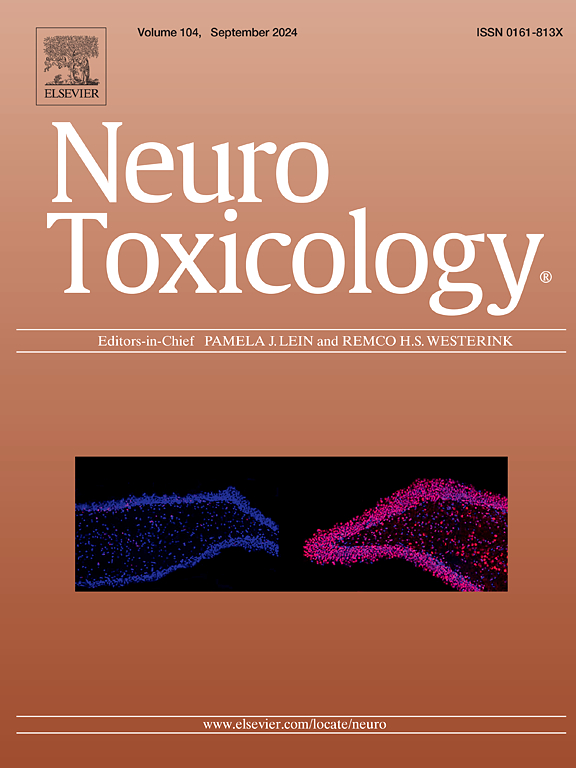秀丽隐杆线虫作为神经毒性评估的有力模型
IF 3.9
3区 医学
Q2 NEUROSCIENCES
引用次数: 0
摘要
秀丽隐杆线虫(秀丽隐杆线虫)由于其良好的神经系统特征、遗传易变性和与人类分子通路的高度保守性,已成为神经毒理学研究的重要工具。这些特点使研究神经毒性物质引发的细胞和分子机制成为可能。在秀丽隐杆线虫中,行为、分子、神经生理和神经元形态学分析,以及针对多巴胺能、谷氨酸能、gaba能和胆碱能神经元的遗传模型,以及线粒体功能障碍和氧化应激模型,对于阐明神经毒性机制具有重要价值。此外,秀丽隐杆线虫被广泛用于高通量神经毒性筛选,自动化系统提高了可扩展性和准确性。尽管具有优势,但秀丽隐杆线虫在将数据转化给人类方面存在一些局限性,包括缺乏血脑屏障和复杂的大脑区域,以及新陈代谢的差异。然而,它仍然是神经毒性筛选和机制研究的有力模型。这篇综述提供了一个更广阔的、更新的视角,不仅涉及经典的神经毒物(如重金属、农药),还涉及越来越相关的物质,如微塑料和工业化学品、精神药物和滥用药物。它还提供了各种秀丽隐杆线虫的行为,分子和神经生理神经毒性测定的详细概述,以及神经递质信号,线粒体功能障碍和氧化应激的遗传模型。重要的是,它还讨论了秀丽隐杆线虫在诸如不良结果通路(AOPs)等调控框架中的相关性,这在以前的综述中很大程度上被忽视了。这些特征解决了当前文献中的空白,并将这项工作与现有的关于该主题的评论区分开来。本文章由计算机程序翻译,如有差异,请以英文原文为准。
C. elegans as a powerful model for neurotoxicity assessment
The small nematode Caenorhabditis elegans (C. elegans) has emerged as a valuable tool in neurotoxicology due to its well-characterized nervous system, genetic tractability, and high conservation of molecular pathways with humans. These characteristics allow to study cellular and molecular mechanisms triggered by neurotoxic substances. In C. elegans, behavioral, molecular, neurophysiological, and neuronal morphology assays, together with genetic models targeting dopaminergic, glutamatergic, GABAergic, and cholinergic neurons, as well as models for mitochondrial dysfunction and oxidative stress, are valuable for elucidating mechanisms of neurotoxicity. Additionally, C. elegans is widely used for high-throughput neurotoxicity screenings, with automated systems enhancing scalability and accuracy. Despite its advantages, C. elegans has some limitations for translating data to humans, including the absence of a blood-brain barrier and complex brain regions, as well as differences in metabolism. However, it remains a strong model for neurotoxic screening and mechanistic studies. This review offers a broader, updated perspective by addressing not only classical neurotoxicants (e.g., heavy metals, pesticides) but also increasingly relevant substances like microplastics and industrial chemicals, psychotropic medications, and drugs of abuse. It also provides a detailed overview of diverse C. elegans behavioral, molecular, and neurophysiological neurotoxicity assays, and genetic models for neurotransmitter signaling, mitochondrial dysfunction, and oxidative stress. Importantly, it also discusses the relevance of C. elegans within regulatory frameworks such as adverse outcome pathways (AOPs), a connection largely overlooked in prior reviews. These features address gaps in the current literature and distinguish this work from existing reviews on the topic.
求助全文
通过发布文献求助,成功后即可免费获取论文全文。
去求助
来源期刊

Neurotoxicology
医学-毒理学
CiteScore
6.80
自引率
5.90%
发文量
161
审稿时长
70 days
期刊介绍:
NeuroToxicology specializes in publishing the best peer-reviewed original research papers dealing with the effects of toxic substances on the nervous system of humans and experimental animals of all ages. The Journal emphasizes papers dealing with the neurotoxic effects of environmentally significant chemical hazards, manufactured drugs and naturally occurring compounds.
 求助内容:
求助内容: 应助结果提醒方式:
应助结果提醒方式:


